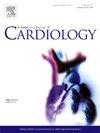CABANA研究中通过聚类分析确定的房颤表型
IF 3.2
2区 医学
Q2 CARDIAC & CARDIOVASCULAR SYSTEMS
引用次数: 0
摘要
本研究旨在利用聚类分析来改善房颤患者的表型,评估已确定的聚类的长期临床结果,并检查这些聚类对消融与药物治疗有效性的影响。方法采用CABANA试验数据,采用12个临床变量对2205例患者进行聚类分析。主要终点是死亡、致残性中风、严重出血或心脏骤停的复合终点。我们比较了不同组间主要终点和全因死亡率的差异。此外,我们分析了每个组内治疗结果的差异。结果在2205例患者中,我们使用k -原型聚类分析确定了三种不同的AF表型。聚类1以女性为主(69.0%),发作性房颤比例最高(61.7%)。聚类2为最年轻的雄性显性表型(89.4%)。集群3代表最古老的AF表型,并伴有多种合并症。与集群1相比,集群2的主要终点风险相似(HR 0.83, 95% CI 0.55-1.25;P = 0.369)和全因死亡率(HR 0.92, 95% CI 0.57-1.48;p = 0.727)。相比之下,第3组的主要终点风险更高(HR 2.38, 95% CI 1.69-3.35;P & lt;0.001)和全因死亡率(HR 2.06, 95% CI 1.35-3.41;p = 0.0001)。通过聚类分析,我们将CABANA试验参与者分为三种不同的AF表型,它们具有不同的临床特征、预后和对治疗的反应。这些发现强调了房颤的异质性,并提示需要针对个体患者的特点制定个性化的治疗策略。临床试验注册:ClinicalTrials.gov标识符:NCT00911508本文章由计算机程序翻译,如有差异,请以英文原文为准。
Atrial fibrillation phenotypes identified through cluster analysis in the CABANA study
Background
We aimed to use cluster analysis to improve phenotyping of patients with AF, assess the long-term clinical outcomes of the identified clusters, and examine the impact of these clusters on the effectiveness of ablation versus drug therapy.
Methods
Using data from the CABANA trial, we performed cluster analysis on 2205 patients using 12 clinical variables. The primary endpoint was a composite of death, disabling stroke, serious bleeding, or cardiac arrest. We compared the differences in the primary endpoint and all-cause mortality across clusters. Additionally, we analyzed the differences in treatment outcomes within each cluster.
Results
Among the 2205 patients, we identified three distinct AF phenotypes using K-prototype cluster analysis. Cluster 1 predominantly included females (69.0 %) and had the highest proportion of paroxysmal AF (61.7 %). Cluster 2 consisted of the youngest male-dominated phenotype (89.4 %). Cluster 3 represented the oldest AF phenotype with multiple comorbidities. Compared to Cluster 1, Cluster 2 had a similar risk of the primary endpoint (HR 0.83, 95 %CI 0.55–1.25; P = 0.369) and all-cause mortality (HR 0.92, 95 % CI 0.57–1.48; P = 0.727). In contrast, Cluster 3 exhibited a higher risk of the primary endpoint (HR 2.38, 95 % CI 1.69–3.35; P < 0.001) and all-cause mortality (HR 2.06, 95 % CI 1.35–3.41; P = 0.0001).
Conclusions
Through cluster analysis, we stratified CABANA trial participants into three distinct AF phenotypes with varying clinical characteristics, prognoses, and responses to treatment. These findings underscore the heterogeneity of AF and suggest the need for personalized treatment strategies tailored to individual patient characteristics.
TRIAL REGISTRATION ClinicalTrials.gov Identifier: NCT00911508
求助全文
通过发布文献求助,成功后即可免费获取论文全文。
去求助
来源期刊

International journal of cardiology
医学-心血管系统
CiteScore
6.80
自引率
5.70%
发文量
758
审稿时长
44 days
期刊介绍:
The International Journal of Cardiology is devoted to cardiology in the broadest sense. Both basic research and clinical papers can be submitted. The journal serves the interest of both practicing clinicians and researchers.
In addition to original papers, we are launching a range of new manuscript types, including Consensus and Position Papers, Systematic Reviews, Meta-analyses, and Short communications. Case reports are no longer acceptable. Controversial techniques, issues on health policy and social medicine are discussed and serve as useful tools for encouraging debate.
 求助内容:
求助内容: 应助结果提醒方式:
应助结果提醒方式:


